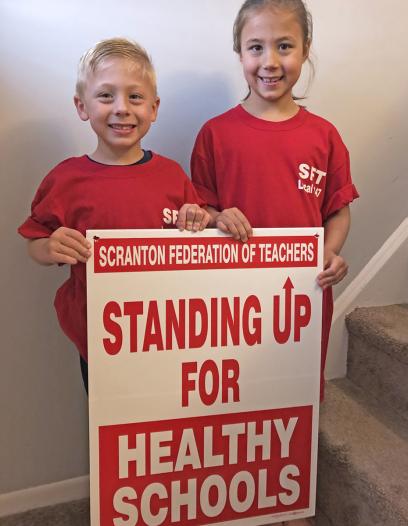When the Scranton (Pa.) School Board proposed a hybrid reopening model this fall, the Scranton Federation of Teachers knew it was the wrong move. Too many crucial safety variables hadn’t been figured out, from classroom ventilation to cleaning supplies. So the SFT mobilized educators and parents to persuade the board to reconsider. Educators are eager to return to the classroom once it’s safe, and want to do their best to make remote learning as good as possible in the meantime.
“We asked the board to look at the value of human life,” says SFT President Rosemary Boland. “This virus is deadly. The governor said you could not have more than 25 people in a classroom, and class sizes looked likely to exceed that. We’ve seen what happened in Georgia. We didn’t want that to happen here.”
The union drove unprecedented turnout to board meetings. At the Aug. 3 meeting (which went past midnight with all 58 speakers advocating virtual reopening), one board member expressed impatience with these “plain old teachers.”
“Our members wore that like a badge,” says SFT Second Vice President and third-grade teacher Pat Festa. “They introduced themselves that way the rest of the night, ‘I’m so and so, and I’m a proud plain old teacher.’ ”
Using social media, the SFT mobilized parents for a district survey on reopening options. A whopping 6,151 parents responded, in a district of 10,000 students. Two-thirds favored a virtual start. That included parents and teachers Matt and Jenn Loftus, who knew they could not let their 4- and 6-year-old return to bricks-and-mortar school this quarter.
“It’s the unknown,” says Jenn, a first-grade teacher at John Adams Elementary School. “No one can say with certainty that our children would be completely safe going back. Even the most affluent districts can’t figure it out.”
“This is something every parent has been dealing with. I’d love to be back at bricks and mortar, but only when it’s safe,” says SFT First Vice President Matt Loftus, who teaches chemistry at Scranton High School.
An SFT-led car caravan around the board office drove the point home. The upshot: Scranton schools will open virtually and stay that way until at least November.
“That’s the power of the union,” says Festa. “That’s our job, to speak up for the kids we serve, to say ‘Safety is priority number one.’ ”
Lessons from a spring of change
Like many districts when school doors closed abruptly last spring, Scranton schools scrambled.
Boland says, “Our district’s schools average 82 percent of students living in poverty, but some schools are as high as 97 percent. We have 2,000 special education students, one-fifth of our student population. There are 32 languages spoken in our schools. It was not simple to suddenly go remote. For teachers, the workday went till whenever.”
For the fall, the union insisted on three professional days so teachers and staff can master a new cyber curriculum and look at addressing the challenges students and their families face.
“I discussed with administrators that we need flexibility above all,” says Matt Loftus. “Many working parents can’t work with their children during regular school hours. So we need recorded lessons. We need to realize that we can let some kids do it a day late if they need to.”
Jenn Loftus agrees: “In spring, kids were submitting work at midnight, and I’d be up checking it. None of this is normal for anybody, but we’re trying to figure it out. If it doesn’t work, we’re doing our best to fix it.”
Festa says collaboration saw his school, McNichols Plaza Elementary, through the first months of virtual learning. “This spring, I talked more to my colleagues. I had panic attacks. Sometimes we were the tech support for families trying to get online. Sometimes I’d call my 25-year-old daughter [who teaches elementary school in Philadelphia] for help. But I never worried about teachers rising to the occasion. That’s what we do.”
As the pandemic unfolded, a bright spot was seeing the national AFT swing into action.
“I’m a union person, and Scranton is a union town. I’m proud of that,” says Boland. “And I’m proud that the AFT has been on the frontlines. They spent more than $2 million on PPE to keep their members safe. It’s not exaggerating to say that that saved some lives. I don’t know anybody else who did that.”
Matt Loftus says, “AFT staff have been in constant contact with us. AFT made sure we had the research we needed to make our case for virtual reopening. They helped us set up a town hall for our members. They gave us health and safety training. That support was critical.”
A vision for when the doors reopen
Boland says much will be needed to rebuild and recover when schools are back in session.
“The certified school nurse is the frontline healthcare provider,” she says. “We don’t have enough of them. We don’t have enough specialized instructional support personnel. We only have two guidance counselors for all 11 schools.”
Funding will be key, Boland points out. “We want to go back to work. A second federal COVID relief package has got to be passed to get us the safety we need to do our jobs and for children to return to school.”
It’s about priorities, Jenn Loftus says: “They bailed out the banks and airlines, why not properly fund schools? We’re asking for the funding to keep the kids safe. Why are we villainized for that?”
Festa hopes returning will mean re-centering. He says, “Kids are missing their friends right now. Funny, I’ve never heard one parent say, ‘My kid misses that standardized test.’ The truth is, children remember moments. They remember art and music and expression. This past school year, we didn’t give the PSSA [state standardized] test. No sinkhole opened. Nothing happened. Life continued. Maybe when this is over, the powers that be will sit down and realize what truly matters in a child’s education.”
[Christina Bartolomeo]


